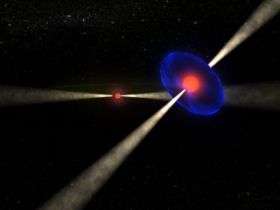Einstein was right: Unique stellar system provides 'laboratory' for testing relativity

Researchers at McGill University's Department of Physics – along with colleagues from several countries – have confirmed a long-held prediction of Albert Einstein's theory of general relativity, via observations of a binary-pulsar star system. Their results will be published July 3 in the journal Science.
Pulsars are small, ultradense stellar objects left behind after massive stars die and explode as supernovae. They typically have a mass greater than that of our Sun, but compressed to the size of a city like Montreal. They spin at staggering speeds, generate huge gravity fields and emit powerful beams of radio waves along their magnetic poles.
These illuminate Earth-based radio-telescopes like rotating lighthouse beacons as the pulsar spins. More than 1,700 pulsars have been discovered in our galaxy, but PSR J0737-3039A/B, discovered in 2003, is the only known double-pulsar system; that is, two pulsars locked into close orbit around one another.
The two pulsars are so close to each other, in fact, that the entire binary could fit within our Sun. PSR J0737-3039A/B lies about 1,700 light years from Earth.
This new test of Einstein's theory was led by McGill astrophysics PhD candidate René Breton and Dr. Victoria Kaspi, leader of the McGill University Pulsar Group.
"A binary pulsar creates ideal conditions for testing general relativity's predictions because the larger and the closer the masses are to one another, the more important relativistic effects are," Breton explained.
"Binary pulsars are the best place to test general relativity in a strong gravitational field," agreed Kaspi, McGill's Lorne Trottier Chair in Astrophysics and Cosmology and Canada Research Chair in Observational Astrophysics.
""Einstein's theory predicted that, in such a field, an object's spin axis should slowly change direction as the pulsar orbits around its companion. Imagine a spinning top when its slightly non-vertical: the spin axis slowly changes direction, an elegant motion called 'precession.'"
The researchers discovered that one of the two pulsars is indeed precessing -- just as Einstein's 1915 theory predicts. If Einstein had been wrong, the pulsar wouldn't be precessing, or would precess in some other way.
Pulsars are too small and too distant to to allow us to directly observe their orientation, the researchers explained. However, they soon realized they could make such measurements using the eclipses visible when one of the twin pulsars passes in front of its companion. When this occurs, the magnetosphere of the first pulsar partly absorbs the radio "light" being emitted from the other, which allows the researchers to determine its spatial orientation. After four years of observations, they determined that its spin axis precesses just as Einstein predicted.
Even though spin precession has been observed in Earth's solar system, differences between general relativity and alternative theories of gravity might only shake out in extremely powerful gravity fields such as those near pulsars, Breton said.
"However, so far, Einstein's theory has passed all the tests that have been conducted, including ours. We can say that if anyone wants to propose an alternative theory of gravity in the future, it must agree with the results that we have obtained here."
Breton, Kaspi and colleagues in Canada, the United Kingdom, the U.S., France and Italy studied the twin-pulsar using the 100-metre Robert C. Byrd Green Bank Radio Telescope at the National Radio Astronomy Observatory in Green Bank, WV.
"I think that if Einstein were alive today, he would have been absolutely delighted with these results," said Dr. Michael Kramer, Associate Director of the Jodrell Bank Centre for Astrophysics at Manchester University. "Not only because it confirms his theory, but also because of the novel way the confirmation came about."
Spin Precession:
Time-lapse animation displaying the evolution of pulsar B's geometry in the double pulsar PSR J0737-3039A/B due to relativistic spin precession between January 2004 and January 2029. The truncated dipolar magnetosphere of pulsar B, shown as a colored dipolar structure, rotates about its spin axis, pictured as a diagonal rod. The apparent orbital motion of pulsar A during the eclipse corresponds to the horizontal black line intersecting pulsar B's magnetosphere. Relativistic spin precession is similar to the wobbling of a spinning top and induces a motion of the spin-axis orientation around the orbital angular momentum, which is vertical in this movie. The theoretical light curve corresponding to the eclipse animated in the upper panel is drawn in the lower panel. The angle phi corresponds to the longitude of the spin axis, with 0 degree being the direction coincident with the line of sight. [(MOV, 5.9 MB) Credit: Rene Breton, McGill University]
Pulsar Sound:
This audio file is the sound that one would hear if the radio signal detected from PSR J0737-3039A by the radio telescope was noise-filtered and amplified into an audio device. While individual pulsations from the pulsar are too fast to be distinguished, we can hear a mixture of F musical tones harmonically related to 44 Hz (F1 tone), the spin frequency of the pulsar. The sound is modulated in intensity as a result of the eclipse when the pulsar passes behind its companion pulsar. [MP3 Version (1.1 MB), Credit: René Breton]
Source: McGill University





















